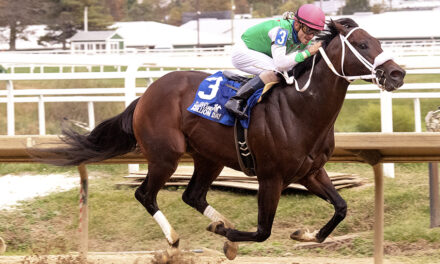See March issue, now in stores, for a complete analysis!
On Tuesday, February 8, 2011, the Maryland Department of Agriculture released the results of the 2010 Equine Census, which did a little more than just count noses; it yielded some economic data, land use data and much more.
The study values the horse industry’s assets at $5.6 billion and expenditures just under $513 million.
According to the 2010 study, there are approximately 81,000 equine animals in Maryland, down 7% or about 6,000 from 2002. The numbers – while down – are not nearly as down as industry leaders feared, despite a steady exodus of racing-related breeding operations, and that is good news.
The value of the equine inventory on May 1, 2010, was just over $746 million, up 10% from 2002. The number of equine places throughout Maryland decreased 21% from 2002 and includes boarding facilities, commercial and private breeding places, farms, commercial race related places and private residence where recreational equine are kept. Again, the decrease in the number of facilities is not surprising and it fits with trends seen in Maryland breeding associations, show organizations and even here, at The Equiery. Have you seen our real estate section lately? There are some good buys out there for anyone who wants to take leap of faith and jump into the horse biz!
These 81,000 horses are located at 16.040 locations throughout the state, including public and private facilities.
The two largest equine counties are Prince George’s and Baltimore at 9,000 and 8,950 head respectively. To many, it may seem odd that an “ex-urban” county (county on the edges of an urban population, typically giving that county stats more akin to their urban neighbors than their suburban neighbors, hence “ex-urban”) has so many more horses than, say, Montgomery County. However, this study took into account horses stables at the Bowie Race Track, Prince George’s Equestrian Center and the Prince George’s County side of Laurel Park, which is where the stabling is located. These facilities had to report the number of horses on the property at that given moment, hence perhaps a bit of a bounce for Prince George’s that is not enjoyed by other counties.
Equine operations account for a total of 587,000 acres of which 188,000 acres are devoted to equine and 88,000 acres are enrolled in land preservation programs.
Before releasing the data to the public, the results were shared with Governor O’Malley. “These data show the significant value and size of the equine industry in Maryland and serve as confirmation of the economic importance of this viable industry to the State,” said Governor Martin O’Malley. “We are committed to fostering Maryland’s equine industry and doing all we can to protect the thousands of jobs that depend on our rich history of horse racing and recreational riding.”
“Governor O’Malley has taken a keen interest in Maryland’s equine industry and this census validates its vibrant economic and cultural importance,” said Jim Steele, chair, Maryland Horse Industry Board and manager of Shamrock Farm in Woodbine. “The numbers reflect what we expected to see based on the current economic climate. The data show the importance of the industry as a whole from race horses to the pleasure-riding segment.”
The 2010 equine census is the second official count of all breeds (horses, ponies, donkeys, mules and burros) in Maryland. The first census results were announced in 2002. The Maryland Horse Industry Board commissioned the USDA National Agricultural Statistics Service field office in Annapolis to conduct both efforts. The most recent census is a more in-depth questionnaire that collected new information including labor and wages and a breakdown of equine-related expenditures by category (capital, operating).
“The results of the 2010 Maryland Equine Census help illustrate growing trends throughout industry, both at the County and State-level,” said Barbara Rater, State Director of USDA’s National Agricultural Statistics Service, Maryland Field Office in Annapolis. “It shows the economic scope and importance of the industry in Maryland.”
Census forms were mailed in April, 2010, to more than 24,000 potential equine owners and stable operators in all segments of the industry from racing to recreational riding. The census asked for information on the sale of horses, land area allocated to equine uses, number of horses owned, expenditures, and value of assets. The results reflect the number of equine animals in Maryland on May 1, 2010, and expenditures and assets during the 2009 calendar year.
Race horse breeds (Thoroughbreds and Standardbreds) account for 31,300, or 39 percent of all breeds. Light breeds such as Arabian and Quarter Horse, Warmbloods and various crosses make up 39,600 animals or 49 percent of all breeds. Draft breeds, ponies, mules, donkeys and burros comprise the balance of the 81,000 animals.
For more analysis and interpretation of all the numbers, check out the March 2011 issue of The Equiery. Contact us to subscribe: 1-800-244-9580, or info@equiery.com, or visit www.equiery.com
Click here for a copy of the census data as presented to the Maryland Horse Industry Board.
General Media picks up Maryland’s equine census story:











